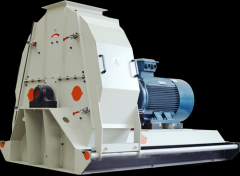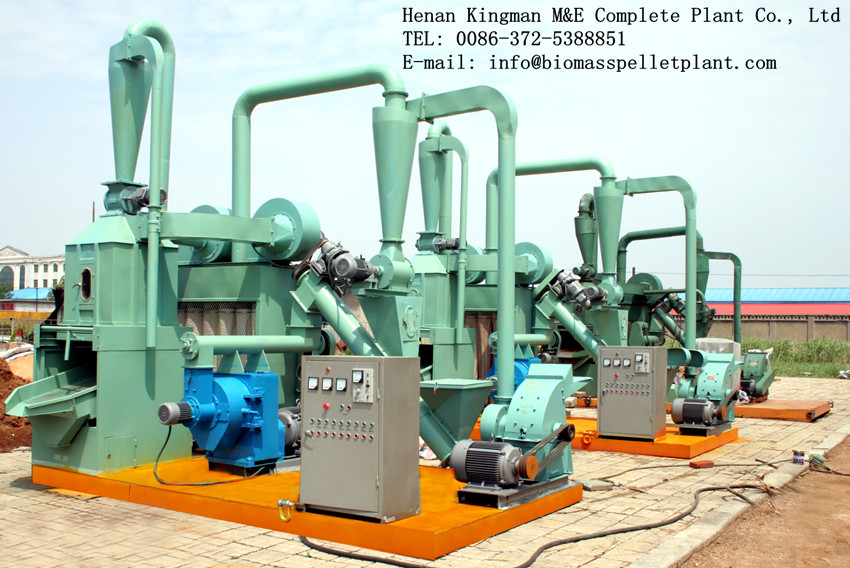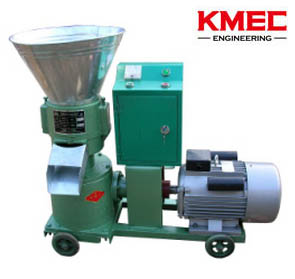Basic Knowhow of Ring Die of Biomass Pellet Mill (Part 1)
Biomass Pellet Mill Ring Die Metallurgy
The ring die biomass pellet mill was designed at around the 1930’s based on the design of ring die. The basic pelleting principle of the ring die biomass pellet mill is a simple operation where feedstocks are distributed over the inner surface of a rotating, perforated die ahead of each roll, which compress the feedstock into the die holes to form pellets. It can also be used to produce fuel and feed pellets. However, comparing with the plat die pellet mill, the ring die biomass pellet mill is well known for its large capacity for pellet production with nice pellet forming shape, high density and high energy consumption.
Ring die, also known as ring mold, is the core of a biomass pellet mill. The success of a wood pellet plant is also due largely to the mold of pellet press. Therefore, more and more clients who are intend to set their foot on the biomass energy career start pondering over the importance of ring die. Actually ring mold is made from not just one substance, with basic physical properties of the materials strictly controlled via the heat treating process and the composition of the die’s steel. We would like to set clients up with ring die, because we hope you can realize the protagonist of a pellet plant.
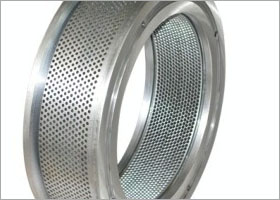
Link to what is What Is Die in Pellet Mill now
Carbon and Chromium
Carbon and chromium, the two most pivotal ingredients of pellet mill dies, should be predominantly touched upon. The steel carbon content as a matter of fact impacts the corrosion resistance and the wear resistance of a die. Technically, steel with free chromium content above 12% is classified as stainless one. Chromium carbides are formed during the heat treatment process through a combination of chromium and carbon atoms, which increases wear resistance. There is no such thing as a rust free “stainless steel”.
Heat Treating: carburizing vs. neutral hardening
Generally, ring dies experience heat treatment in two different ways, either carburizing or neutral hardening. Case carburizing dies can be done in a pit furnace or in a vacuum furnace by the addition of a carbon rich gas, such as propane. Our alloyed ring mold is processed in the pit furnace, whereas the other kind is vacuum carburized. When carbon is added into the atmosphere of either of these furnaces, it soaks into the steel to form a hard case. Case carburized dies tend to create more friction in the pelletizing chamber, meaning they will usually provide better quality pellets.
Neutral hardening is a process that gives the same relative hardness throughout the thickness of the die. One of these steels is Kingman Chrome Plus. Due to its homogeneous hardness throughout, Chrome Plus offers excellent die life. Neutral hardened dies tend to be easier to start. Alloy is a medium-grade carbon steel which is case carburized for a hard outer case and a soft core. Another is a stainless steel which is carburized in a vacuum for a hard case and a soft core. Chrome Plus is neutral hardened through the thickness of the die.
Die Material Application
Each material has characteristics that may make it more desirable than another for an application. Alloy is the most breakage resistant die material currently offered, which means that it is best suited for heavy tramp metal situations. Alloy has been used in heavily abrasive situations where die life with other die materials is not significantly longer in order to keep cost/ton ratios low. Alloy, at the lowest price, is also used extensively with high mineral content applications.
Kingman has also developed another kind of ring dies for biomass pellet mills which can be used in mildly corrosive applications. Because of its case carburization and hole erosion characteristics, it should only be used with customers whose primary concern is pellet quality. It works well with moderately to highly abrasive materials which tend to keep the pellet hole inlets open. The best wear characteristics and throughput seem to be achieved with closer hole patterns, especially with smaller hole diameters. Reducing ligament thickness lessens the occurrence and severity of rollover. Rotating the pattern had much the same effect. In this case, thicker die blanks should be used. Even though it is a stainless steel, it will rust or corrode.
Chrome Plus allows high throughput and die life at the expense of pellet quality. It should be used in extremely high corrosion applications, high throughput applications and extended die life applications. Pellet quality may be significantly lower than carburized dies in the first half of a die’s life. It performs well with abrasive applications where pellet quality is not an important issue. Chrome Plus needs more effective thickness to achieve quality similar to carburized dies. When changing from a carburized die to Chrome Plus always increase the blank thickness.
Die Design Features
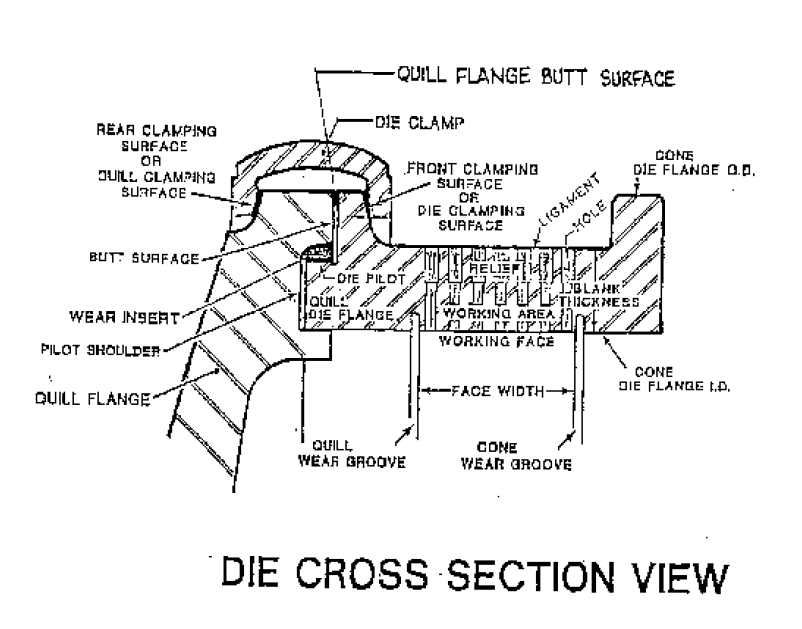
The physical characteristics of a biomass pellet mill die can determine its performance through the blank and effective thickness, the reliefs and the hole pattern. Perhaps the most important physical characteristics of a biomass pellet mill die are the blank thickness and the effective thickness. The blank thickness determines the overall strength of the die. The thicker the blank, the more it resists deflection caused by the rollers. Blank thickness should be increased instead of ligament thickness, especially in cases of repeated circumferential breakage.
Effective thickness is the length of the pellet chamber that will perform the pelletizing. Effective thickness governs the amount of work the ring die will perform on a material, increasing pellet quality.
It also controls the amount of stress added to a die – more thickness = more stress. Changes in material necessitate changes in effective thickness due to changes in the materials coefficient of friction.
Reliefs were developed so that increased blank thickness could be used with applications that needed thinner effective thicknesses. Currently, there are two major types of reliefs: straight hole and tapered. Straight holes can be oversized, while tapered holes can be at different angles. Tapered reliefs over 1.000” are extended by adding a straight relief to it. These two reliefs can be drilled in three methods: variable, non-variable, and special variable.
The hole pattern is the major factor in determining a ring die’s wear pattern. Each of the above types of pattern can have one of the three types of ligaments. Close is used for easy running, high throughput feeds. Benefits of the close pattern include increased throughput, better die face wear, and easier startup. Spreading the feed over more holes in the close pattern also retains pellet quality over life of the die. Increased amounts of steam to feed will mean more heat and moisture. Conditioning is improved, pellet quality increases, die life increases and operating costs decrease (lower operating amperages, power savings). Standard is the normal pattern and Heavy is used in high pressure, hard running feeds. These patterns, when applied to various materials, will give you different results. Every opportunity should be taken to get maximum hole count in a die as it increases throughput and die life.
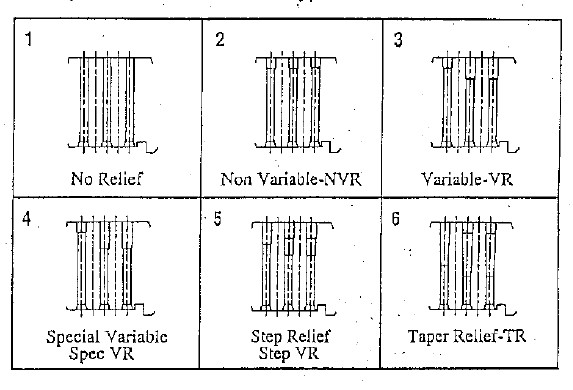
Die Inspection
Keeping accurate and complete tonnage reports allows the study of individual ring dies and the compilation of this information enhances the proper review of specifications.
Review of the various die categories.
The most important result is tonnage. Tonnage is the basis for evaluating your costs and productivity.
Hours run is an equally important statistic because it details the rate at which the product flowed through the die.
Tramp metal is a source of potential damage to a die.
Depth of wear has significant impact on both quality and throughput of biomass pellets.
Honeycombing is indicative of a section of pellet mill die that has worn well, maintaining a steady throughput.
Rollover is a peening action that closes the hole entrance, decreasing throughput and increasing the stress on the die.
Pitting is a common result in pellet mill dies which are not corrosive resistant. Corrosion occurs in the pelletizing chamber, slowing the production.
Scoring is caused by highly abrasive material eroding a groove in the pelletizing chamber.
Clamping surfaces show the state of the mating surfaces with the die.
Breakages occur in three major categories. Circumferential is related to the strength of the die blank. Blowouts are when part of the pattern releases from the die face, More often than not, a circumferential break is present. Flange failures are the result of a snapping or stretching motion.
Depth of Wear
The most noticeable and important trait of any worn die is the depth of the surface wear experienced by the die face. The depth of surface wear is defined as the perpendicular distance to the die face from the horizontal plane that marked the original die face surface. This information is recorded in three sections: the cone, the center, and the quill.
Cone readings are taken in the front third of the die face, while center and quill readings are taken in the thirds of the die face bounding their respective areas. A good standard practice is to take these measurements in the exact center of the die and three rows in from each flange. This helps bring consistency to the measurements. The only exception to these locations would be if there was an exceedingly deep band of wear in an area, then the measurement should be taken in the deepest spot.
The depth of wear measurement gives important information concerning feed distribution by evaluating which portion of the ring die is worn the deepest. This measurement identifies worn wipers and deflectors as well as unevenly worn roller shells.
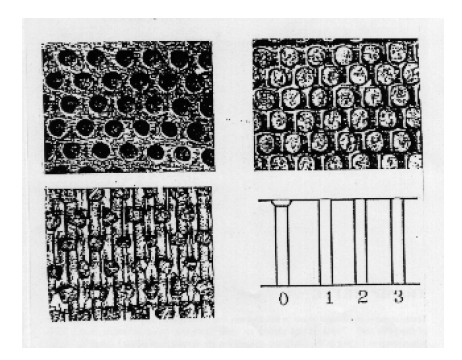
Rollover
Rollover is the condition of the die face when the hole inlets start to peen closed. This peening action will have dramatic effects on both the pellet quality and the throughput of the die, usually lowering both. Rollover is caused when the force exerted on the face of the ring die exceeds the toughness of the die material. Roller adjustment and certain types of feed exert excessive stresses on the die face, initiating rollover.
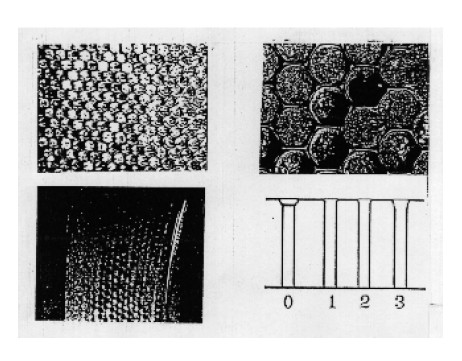
Honeycombing
Honeycombing is the result of the abrasive wear of the pelletized material enlarging the hole entrance on the ring die face. This action at its most severe may result in a serious reduction of the ligament thicknesses between holes. It is characteristic of a honeycombing condition for the ligaments to round at the tops, allowing material to flow into the holes. Honeycombing in its mild state is an indication of a good producing die and is characteristic of Chrome Plus material. The illustrations show cross sectional appearance and die face appearances of common honeycombing.
Link to Kingman Biomass Pellet Mill
Pitting
Pitting is a condition caused by corrosion, which is the result of the effects of moisture and heat combining with the feed in a ring die. Pits appear as small places of micro corrosion that grow as the die continues to wear. Pitting slows down a ring die by reducing the throughput and often can reduce pellet quality due to the rough surface created inside the hole. This is especially true for cube dies, which are more prone to the effects of pitting.
More severe pitting will appear as larger blotches.
WARNING: Make sure that all the sediment has been removed from the sides of the holes with either a test tube cleaner or a pipe cleaner.
----------------------------------------------------------------------------------------------------------------------------------
News
- Small Pellet Machine Manufacturer-Kingman
- Application of Wood Pellets and Use of Biomass Pellets
- From Fossil Fuel into Biomass Pellet Fuel
- Biomass Pellet Making Machines Market
- Applying of pellet stoves for home use
- Highland pellets to build $130 million facility in arkansas
- How to deal with the blocked hammer mill
- How to Make Wood Pellets with Sawdust
- The government policy promotes the development of biomass fuel
- Market analysis of biomass pellet fuel
- Strategic positioning of renewable energy
- Biomass energy has pass through the pre assessment
- The key point of deep processing of biomass pellet
- Harbin is promoting the development of biomass machinery
- The development of biomass formation technology I
- The development of biomass formation technology II
- Biomass energy industry is now going full tilt in 2015
- Rapid increasing demand of sawdust pellet on the market
- Pellet fuel market in EU
- Chinese Biomass Energy Conference held in Beijing
- Future market development of straw pellet mill
- Peanut Shell Pellet Mill Makes High Quality Pellets
- The utilization of straw is only 5%, biomass energy needs our attention!
- Corn straw pellet machine relieves the tight supply of fuel energy
- Reasons for loose or not forming of biomass pellet mill


